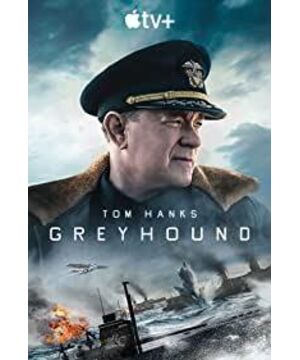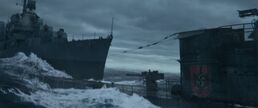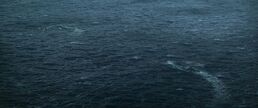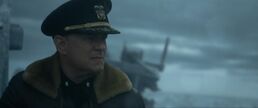(Update 719: Contrast between novels and movies, and the issue of "the drama" / Update 714: The chain of command and bridge personnel in the film / Update 712: Tactical analysis in the first 20 minutes)
As an amateur naval history enthusiast, this film is very exciting, thanks to Tom Hanks.
I searched some film reviews, and most of the foreign critics think that the film lacks the elements of film art, which is understandable. If you don't care about this film's efforts to restore historical details, then "Grey Hound" is a cool film, and as many commentators say, the enemy does not appear, and it lacks meaning in form.
But my understanding is, can the escort ships in the Atlantic know what the enemy is doing when they are anti-submarine? No, they don't know anything. They didn't know until they killed all the people in the opposite boat on the bottom of the sea. There are no face-to-face scenes, no emotional and human impacts for actors to show their acting skills. This is the case.
btw, the only German speaking in the film is to provoke a telegram. Probably it is also the film's opinion that it is not good for the Germans not to say a word? But it's really weird. The flaws don't cover up.
This movie is too much in the style of "Raging Seas".
The same opening composition: In 1805, Napoleon was invincible on the European continent...
And the restoration of the internal personnel, equipment, chain of command, and terminology on a destroyer has reached the level of a textbook.
For example, the captain's manoeuvring skills and orders one after another. This was rarely shown in previous naval battle films. In fact, this is the basis of naval tactics, and any tactical tutorial is the first chapter.
The messenger stammered, sneezed, and hesitated. The watchman forgot to attach higher-level information to the report and was reprimanded. While accurately restoring the chain of command of the warship, it showed the true state of people under the pressure of war.
In terms of technical and tactical details, I have not conducted specific research on anti-submarine warfare. However, judging from foreign reviews, CS Foster hired naval experts as advisers when writing the original novel, so that it was judged that there were almost no errors.
The restoration of the movie is also in line with my understanding of the basic aspects of naval tactics, such as the performance of the shooting angle, the performance of the escort formation, and the performance of the accidental injury of the friendly forces, all of which are unprecedented realism. Except that the rubbing torpedo is slightly too dramatic (although it is entirely possible that the impact fuze cannot be detonated because the angle is too small).
Just discovering the performance of the entire process of the submarine is enough to excite me: Is there any other film that will perform such a precise performance as the CIC workflow of the core department of a warship's tactics (the Fletcher class is the first USN with CIC Destroyer)? What other film will show the real effects of radar screens and sonar oscilloscopes so accurately?
Well, a more detailed analysis is to wait for others to do it. In short, if you look at this movie as a pure popcorn movie like U571 or a literary drama like Dunkirk, you would be too ignorant.
Tom Hanks is not here.
---------------712 update---------------
Perhaps most people do not understand the first submarine hunting incident. After all, it was indirectly represented by oral orders, oral reports, and a very small number of CIC drawings. I didn't understand it the first time I saw it. It was not understood until the English subtitles, a glossary of terms, and the original work were put together. Can't help but sigh that it's too hard-core... Let's start.
1. Let's start here. The XO (Deputy Chief) report of CIC (Combat Information Center, integrated processing radar, sonar, radio and other information, visually presenting the tactical situation through drawing, assisting decision-making/making tactical details) XO (Deputy Chief) report, U boat disappeared from the radar PPI , It seems to dive.
2. The captain ordered CIC to formulate an interception route, assuming that the opponent maintains the original course and the speed is 6 knots.
XO draws the route on the navigation drawing board. Several black dots are the points that the radar locates before diving, and they are connected to determine the opponent's route.
XO reported that the captain's interception position was 096.
Press: I need to introduce the location issues involved in tactics and navigation in this film. There are two types of orientation, absolute orientation and relative orientation, as shown in the figure below:
The CIC drawing board in the movie is an absolute azimuth coordinate map centered on the Greyhound number. That is, 000 is north, 090 is east, and 180 is south. The complete coordinates are similar to the following. This point is recorded here first.
3. The sonar officer reported that the echo continued at position 091, and the enemy ship was turning, as if fleeing from the Greyhound. In order to chase down the enemy ship, the route is directly set to 091.
XO updates the situation in real time on the CIC drawing board.
4. The sonar officer reported that the signal disappeared once, and then received another signal at 091. The captain ordered a 30-degree scan on the starboard and starboard (note that this is a relative position).
As a result, a surprising result came. The U-boat appeared at 066 position and the distance was unknown. (Additionally, the novel is modified here. The original setting is that the submarine appears in the port beam, that is, the port side direction is 001. It is estimated that this setting cannot be completed at the speed of the submarine submarine during the adaptation, so it is changed to The smaller 066)
(I will draw a soul...)
5. The captain ordered "Left full rudder"-"Return to rudder"-"Meet her."
The position of the new course is not introduced here, but according to the novel, the so-called meet her is to maintain the same 066 position as the sonar report to maintain the pursuit.
Then the captain ordered the report to change to the relative position, which is the position relative to the ship. (But not all of them have been changed since then, so we need to pay attention here.)
6. The sonar officer first reported that there was a submarine noise on the starboard side 01, which is 1 degree forward to the starboard side. But immediately reported port 015, 1100 yards of contact. The captain hit the left full rudder again to keep up. The calculation shows that the absolute bearing of the Greyhound route at this time is 051.
7. After turning, the sonar officer reported that the submarine was still 012 on the port side.
Then it was reported that the submarine was at 006 (absolute azimuth here), and the distance was 900 yards.
Corresponding CIC drawing. The submarine's bearing is 006, and the Greyhound's course is 051. In other words, it was thrown away by such a big heading difference, although the distance was narrowed.
At this time, the movie was probably for fear that the audience would not understand it, so the officer next to it reminded him: Sir, it is turning sharply to the left.
8. At this time, the captain made the unexpected decision for everyone (including CIC's XO), that is, "play the standard rudder to the right". Everyone hesitated, and the captain repeated the order.
Looking up the terminology, this word means Put the rudder over to the right (left) the specified number of degrees necessary for the ship to make a standard tactical diameter turn.
In addition, the original text of the novel is right full rudder here, which corresponds to the implementation of a turn with a radius smaller than the standard tactical radius. I think from the point of view of interception tactics, full rudder may be more reasonable (meaning faster interception), but the identity of the captain here is the new captain who has just completed tactical training. It is more secure to choose the standard tactical radius. Decision-making.
XO thought he had to turn sharply to the left to follow the target, and re-drew the picture after hearing the command.
Here needs an important explanation, why turn right instead of left?
The answer given by The Good Shepherd in the original book is this:
The submarine's underwater power is much better than that of the destroyer, so the turning radius is small and the turning is fast. More importantly, there is a time difference between the sonar report and the actual action of the submarine. When the submarine is in the port 015 position, this information will be detected by sonar in half a minute, and the destroyer will start to turn the rudder according to the command. In this one-minute time difference, the submarine can continue to turn and maneuver, and the destroyer will be old again. The direction was several hundred yards away. So when the destroyer determines its course according to the previous sonar report, it will find that the submarine is not directly in front, but on the port side again. The submarine can open the angle and distance, and the best result is that after the destroyer loses the target, it slips away in the other direction.
The advantage of the destroyer is the high speed, so it is found that the submarine can still keep in touch and even close the distance after turning and then turning to chase. But the destroyer turned too slowly and the turning radius was too large (the turning radius of the Fletcher class is 2000 yards, although the Killing in the original book is not the Fletcher class). If you want to keep up with the submarine's turn and play a sharp turn, the turning radius directly exceeds the sonar distance, which is equivalent to giving up the pursuit. If you can't make a sharp turn, you can only be carried by the submarine, and then turn relatively slowly after receiving the lagging position information. Considering this relationship between angular velocity and linear velocity, if this continues, the two sides will circle in a circle, and the destroyer will circle the submarine in a small circle.
(Here is another soul drawing:)
There may be several results of going around in circles. Either the submarine’s battery is exhausted and the submarine fails, or the escort ship is towed here and left the escort formation for too long and is forced to return. Of course, if the escort ship has the patience to slowly wear have advantage of. One thing the novel does not mention here is that the submarine can also slip into the sonar blind zone under the destroyer and then dive deep. In short, this is a slowly grinding situation.
And Captain Krause’s choice is to risk a tactical turn to the right, risking the distance being extended and the sonar missing the target, and gaining a more favorable and straightforward volley situation instead of slowing down with you.
9. The sonar once lost the target during the turn, but after the turn was completed, the target was re-captured. The heading and orientation of the target were good for interception. Right bet.
The CIC drawing situation is as follows:
Press: The coordinate map was originally based on the ship as the center to show the orientation of each target. During the dynamic process of the ship's rotation, the relative positions of other targets will also change rapidly. People can't draw it. At this time, only the orientation coordinates can be drawn. It has become a normal coordinate map. The volley situation is the volley of the dashed Greyhound route against the sonar target on the map, not the Greyhound ship type on the map that still maintains the 051 course.
10. Due to the proper intercept position, the Greyhound was able to quickly approach the target.
The submarine took the last fight, trying to speed up to escape under the destroyer, hiding in the sonar blind zone.
Drop the bomb, Bingo.
The morale of the entire ship was greatly boosted, and the alert level was immediately lowered, and hot meals were arranged. A few cheering scenes, plus this sentence, echoed with XO's introduction of the crew's nervousness and fighting phenomenon, reflecting the multi-level responsibilities of real-world commanders, and also showing Krause's management skills and leadership. .
In this plot, Tom Hanks portrays a highly conscientious, calm, but emotionally nervous commander for the first time. And all of this is naturally presented in a highly tense military decision-making scene with no paving space. Such performance skills are also very remarkable.
---------------712 update 2---------------
Several major bugs found so far:
1- The Fletcher class will not be in service until June 42. The film set to February 42 is really a crossing. The Fletcher-class bridge model in the film is a later model, not an early model of 42 years. Models such as the radar and anti-aircraft guns in the film are also available in the later stages. I can also understand, after all, the real thing used for filming is the USS Kidd preserved in the later state. At the beginning of 42 years, the US destroyers did not have CIC. The integration of radar, sonar and other intelligence was directly connected to the bridge, and there was no graphical version to show the tactical situation of the enemy or the enemy. According to the original work, XO is not in CIC, but in the chart room on the first floor.
At the beginning of 2-42, the Germans did not attack the North Atlantic convoy. It was in late July that Dunnitz began to assemble his forces to plan an attack on the North Atlantic convoy, and the so-called happy hour in early 42 was to use the US coastal routes to not adopt the convoy in time to play single boats along the coast of the United States. The few attacked escorts were mostly Mid-Atlantic escorts rather than North Atlantic routes. The siege in the film will not take place until after August 42.
At the beginning of 3-42, the Americans' anti-submarine tactics were actually far inferior to RN. Students of RN must always learn the whole set of tactics and experience. A fledgling captain can sink 4 submarines after taking some tactical training courses, which is really an exaggerated result. This point is indeed greased and powdered, haha.
4- In short, as old Mathewwu said, it is unnecessary for the film to give a clear time point of February 42. It is better to obscure the specific time according to the novel.
Nevertheless, I don't think it is too much to be too picky. After all, it is a movie, and it can never be as perfect as a historian. It is already very good to be able to restore the anti-submarine warfare and internal operation of the World War II destroyer so realistically.
Transfer a comment from IMDB:
---------------714 update---------------
Chain of command and bridge personnel
The typical organizational structure and chain of command of the US destroyers in World War II are shown in the figure below. The picture is from a standard course textbook of the U.S. Navy in June 1944.
The chain of command shown in the picture is slightly different from the Greyhound in the movie. For example, the executive officer (XO) in the picture also serves as the chief of the voyage, while the Greyhound is separate. But apart from this point, it's basically the same.
The captain occupies the highest position in the chain of command, with the highest authority and overall command power. Under it is the deputy commander. The deputy commander does not have independent command power. His specific responsibility is to implement and supervise the execution of the captain’s orders, but he has a higher authority than others. The various departments under it, such as power, military equipment, damage management, navigation, and logistics, are directly responsible to the captain, and all information is reported to the captain.
But in World War II operations, the chain of command on the paper in the picture was actually changed. This is CIC. CIC is not an independent department, but an intelligence integration, processing, research and judgment, and distribution organization that integrates multiple departments. Prior to CIC, intelligence and information from radar and radio sources were directly reported to the captain. However, with CIC, it was first sent to CIC. Only particularly important or processed information by CIC would be reported to the ship. long.
For real CIC, the personnel include the chief CIC officer (XO concurrently in the film), radar operators, plotters, recorders, telephone communicators, etc. USS Kidd was extremely crowded in the CIC at the end of the war. As many as 12 people were crowded in a small space. After all, special personnel were required to be responsible for air-to-sea and submarine, and to ensure that all information was accurately transmitted to the captain, gun positions, and Torpedo launching department, antiaircraft artillery, etc.
According to the 45-year CIC manual, the distribution of Fletcher-level CIC personnel is as follows:
In this way, the number of CIC personnel in the movie is much less. I don’t know if it is greatly simplified for shooting, or is it simpler in the early days? I haven't studied this aspect (although, the time set in the movie is actually the destroyer CIC has not yet come out). The novel The Good Shepherd is basically a generational to CIC, and XO's location is arranged in the chart room on the upper floor of CIC. But the movie changed XO to be responsible for CIC, which is also in line with the practice of the US military in World War II.
The focus of novels and movies is actually the bridge where the captain is. However, the characters in the bridge mentioned in the novel are only a few, and the movie obviously reproduces the entire command environment in history after referring to historical documents.
According to the division at the time, the open-air part is the narrow bridge, and the indoor space is called the pilot house. Let's call it the open-air bridge and the nautical bridge. The captain spent most of his time commanding inside the nautical bridge, and occasionally went out a few times. After all, the North Atlantic was too cold and it was a problem to receive information on the open-air bridge.
The personnel on both sides of the open-air bridge are signalmen and watchmen. This signal soldier did not send a radio, but used a searchlight to signal and interpret the signal. The ordinary audience of these people has no problem understanding.
Here is where the common face blindness may occur: Who is with Tom Hanks on the nautical bridge? What do they do?
The following two pictures are compiled by me according to the credits of novels, movies, and some historical documents. The main position is marked, the specific personnel may change, but the position is basically fixed. These are the things that appear inside the nautical bridge in the movie.
From left to right: telephone communicator, messenger, helmsman, car clockman, duty officer and navigator, and deputy sailor
Left to right: helmsman, messenger, telephone communicator, torpedo officer and assistant gunner, assistant on duty officer
The staff layout of the fool version is as follows:
The first thing worth mentioning is OOD, or officer of the deck. I translated it as an officer on duty. In fact, the importance and powers and responsibilities of this post are much more important than those on a night shift. Simply put, this is a rotating post. The rotating officer actually exercises command power on his behalf when the captain is not in the command post. This shows the weight of his powers and responsibilities. The four officers on duty in OOD in the film are all Lieutenants whose rank is second only to XO. When the captain came to the bridge to take over, he also had to say i have the conn.
In the film, the first OOD on duty is Carling, and then the captain announces that he has entered a combat state (general quarter), and then Waston appears and announces that I have the deck and the conn, which means that he is now OOD. After fighting the first submarine and the captain ordered the alert level to be lowered to level three, Waston left and Nystrom took over OOD. Harbutt was on duty during the night battle.
What the film didn't have time to explain was Waston's position as chief of navigation, which was mentioned in the novel. At that time, the U.S. Navy had such a rule: In combat, the chief navigator must serve as OOD. This should be to ensure that tactical maneuvers do not go wrong.
However, since the captain has taken over, OOD is no longer the command post on the nautical bridge. However, he still has higher authority than other members of the nautical bridge, after all, he and the captain are the only rank officers here. So we can see that in the film, it was Waston who reprimanded the whistling and sneezing communicators and winking the hesitant helmsman. The captain looked out from the right side of the navigation bridge, he looked out on the left, and he could also give the captain some tactical advice (in the range of the main gun), but the other members were afraid to speak.
OOD has its own working position, which is the navigation work table or nautical work table drawn on it. The table is stacked with charts, logs, rulers, etc. After all, the most important job of the duty officer is to ensure the safe and correct navigation of warships. He has an assistant to help him watch charts, plan routes, and make records. The job is called quartermaster. (Note: I don’t know why this word is translated into quartermaster in Chinese. It actually originated from the sailing era. The quarterdeck where the command post was located at the time surrounded the positions of the commander.)
The quartermaster I marked, translated as OOD assistant, is actually not accurate, but I don’t know how to translate it properly. Because a quartermaster actually refers to a professional officer who works on a navigating bridge, knows the professional skills of navigation, can set up routes, and make sailing records.
And in the novel, the helm of the Killing (Greyhound) debut is the quartermaster. According to the rules of the U.S. Navy at that time, in combat conditions, the quartermaster must be at the helm, which means that the helm is required to understand navigation skills.
However, I found in the cast list of the movie that all the actors at the helm are called helmsman in the cast list, and I can't determine which type of helmsman is in the movie, so I also marked it in the picture. In fact, the helmsman belongs to sailor, and the quartermaster is an enlisted officer. This is a small omission.
Car clockman, just to mention briefly. The thing he operates is called an engine order telegraph. It is not that he operates it, and the engine accelerates. This is an information transmission device. Once the operation is performed here, the chief engineer sees it, and the chief engineer operates it again. So it is just a telegraph.
Therefore, when the bell fell during the battle and the captain shouted to make up the telegraph post, the official Chinese subtitles were translated into operational telegrams and it was a big mistake.
There is not much else worth explaining. The work content of the telephone communicator and the messenger has been visually displayed in the movie. The deputy sailor, the work content is very complicated. On the nautical bridge, the watchmen and signalmen on the open-air bridge are mainly responsible for their work, so they always stand by the door.
Lopez on the far left is the torpedo officer and assistant gunner, but this time the torpedo is probably not needed anymore, so the main job is the assistant gunner, who is responsible for sending orders and relaying to the gunner, gun positions, and weapons. Corresponding information. Because it is particularly important, an independent telephone communication system. Every time he speaks, it means a fight.
One missed one, Communication Officer (Dawson). When he first appeared, he told the captain that the Admiralty had sent a message, but the captain was busy hitting the submarine and did not let him report until the battle was over. He is the superior of all signal soldiers and radio operators. In addition to his duties, he is also responsible for handling some sensitive information that needs to be encrypted, decrypted, and properly kept. long. Therefore, in many documents that I have seen about destroyer bridge posts, communications officers are also counted as bridge personnel. In addition, the sonar officer behind the navigation bridge is also counted.
In conclusion, in describing the environment and position of the destroyer commander, "Greyhound" corresponds to the memoirs I can find about the bridge duty of the US World War II destroyer, which is highly in line with history. Although the lack of background introduction will make the audience confused (I think it is okay for each character to put a label when they appear), this kind of restrained and accurate expression can also be said to be a self-confident performance, especially when I have completed the research. After that, I became more and more lamented for its excellent intentions.
Today I will write here first, and then I will add some interesting points.
---------------719 update---------------
Many questions in the "Greyhound" movie can actually be answered by comparing them with the novel "The Good Shepherd" in 80%.
First, let's introduce the novel. I have seen many comments that emphasize the religious color of the original work, but after reading it carefully, I don’t think this is a novel with a particularly strong sense of religion. After all, CS Forrester is a professional naval writer, and the religious elements in it are more of a spiritual pillar for the divorced, lonely, and heavy-duty protagonist who can persevere to the end. I think this is understandable, and it is completely unobtrusive in the novel.
What kind of novel is "The Good Shepherd"? To put it simply, put the story and plot of the movie "Greyhound" in half, and add more professional terms that torture ordinary audiences, trivial daily descriptions, and more self-doubt and nervousness about the protagonist. The description of it, that's it. The first elder Lieutenant Colonel Krause is the only center among them. It is not an exaggeration to say that this novel is a record of Krause's crossing the dark trench.
However, the significance of a detailed account is to truly present the true face and essence of war. The so-called climax moments that later generations are keen on, whether it is the moment when the Victory breaks into the French combined fleet or the moment when Jericho's large fleet unfolds on the skyline, they are all given by the writing of the posterity. The parties involved have no time to enjoy this moment. Every minute since receiving the news from the enemy ship, the commander has been highly nervous and fearful of loss. The slight sluggishness of each daily routine will make people instantly anxious.
I don’t remember whether it was Nicholas Rodger or Brian Tunstall. They mentioned in the narrative of the true face of the British and French naval battles in the 18th century. An old commander like Howe exhausted his energy after defeating the enemy and was almost exhausted, and there was no desire to vanish into oblivion. Therefore, they were unable to organize the pursuit after the battle, which made the energetic young people in the fleet resentful who were not in command positions.
The escort mission in the Atlantic battle is more routine, trivial, boring, and stylized than the above-mentioned decisive actions under the historical high light, and the degree of anxiety is not less. The novel of "The Good Shepherd" and the narrative method of "flowing account" adopted by it fully embodies this characteristic.
Back to the plot of the novel and the plot of the movie.
In "The Good Shepherd", Krause and his friendly ship sunk two submarines, and one is suspected of sinking during the night battle. The final result reported to the British army was three ships. This achievement is far beyond historical reality, but it does not appear abrupt in the narrative of the novel. Because the novel's narration of the entire escort war is completely anticlimax.
The first submarine sunk in the novel was the one tracked in the first 20 minutes of the movie, but it was not successfully sunk as in the movie, but escaped the Killing attack by drilling the bottom of the ship. Soon after, Killing encountered it on the way back to the fleet and summoned the Polish destroyer Bliksem (the Eagle in the movie) to join the attack. In the end, Killing blew it up during several rounds of bombing.
After that, until the night battle, the movie fully restored the novel. It's just that the Killing didn't get nothing in that night battle. He rushed towards the submarine at the risk of colliding with the ship, but was fooled by the bait, which is shown in both the novel and the movie. Only after that, he rushed to another submarine and dropped a large number of deep bombs after a complicated maneuver. Someone on the bridge smelled the oil, but Krause didn't, and the sea was dark and indistinguishable. This is a suspected sinking or severely damaged submarine. Throughout the latter half of the night, the Killing and Bliksem attacked the submarine in concert, throwing deep bombs in turn, until the next morning, it was discovered that there were very few deep bombs left.
After that, movies and novels are basically the same. The submarine and Dicky's melee period was slightly modified. First, Dicky was almost exhausted at the time and could only throw one round one round. The second is that the submarine’s naval gun not only wounded Killeen, but also damaged Dicky’s main gun, which was skipped in the film. It is worth pointing out that this is the most exciting battle in the novel, and it is also the last submarine that Keeling sank, but there is no climax in the narrative of the novel.
The "running account" of the novel continues. That night, Bliksem and another merchant ship ate a wave of fan-fired torpedoes and were forced to abandon the ship. The radar found 2 targets. I don't know if it was a submarine. The nervous atmosphere did not ease at all. It was not discovered until the latter half of the night that they were ordinary ships. Krause was on the verge of collapse. The long-term physical pain and sleeplessness made him almost unable to hold on, and he would fall asleep as soon as he sat down.
At the end of the voyage, Krause no longer gave orders as calmly as at the beginning. Instead, there was a single sentence of chatting with XO and friends on personnel, meals and other topics, accompanied by a large description of psychological feelings. People who stay up late for many days from time to time will feel the same after seeing it. On the last day, the plane that came to meet him appeared, and then the British fleet arrived. Krause, who completed the handover, finally fell asleep peacefully while thinking about his career.
If you compare novels with movies, there is no doubt that novels are more realistic, but this is also the advantage of novels.
For example, to show the leg pain caused by the captain’s refusal to sit down for several days, the novel can be described in a few sentences, while the movie must arrange a pair of bleeding feet and ex-wife’s slippers for visual presentation. The handling of the movie is really stupid, but it is also helpless.
Although the escort mission in the novel is fictitious, the atmosphere of a real escort action is as described in the novel. Tighten your nerves all the time and be prepared, may not produce results, but cause psychological problems for your own people. But losing the chain at a critical moment is fatal.
The anti-submarine process is highly stylized, but it is the process of repeating sonar positioning, maneuvering the ship, grasping the position, dropping depth charges, and avoiding torpedoes.
The rhythm of the battle is also the same as described in the novel. After the enemy enters a favorable attack position, it may appear at any time, and the final battle will not start until the end of the voyage. According to the description of the novel, it can be inferred that the U-boat's wolf pack offensive is there. The entire escort ship was basically disintegrated in the night battle from start to finish, so apart from sneaking a wave of torpedoes to kill the Eagle and a merchant ship, there was no more attack.
However, I think people with a little bit of common sense can understand that if the film is made in this way, the ending will end without any occurrence in a high degree of tension, and I am afraid that the audience will have long been scolded to death.
The main changes of the movie to the novel are as follows:
① When the first submarine was sunk, the Greyhound turned right and succeeded directly after volleying. Instead of being described in the novel, Lightning and Greyhound launched another round of combined hunting before sinking.
② In the entire second half of that night battle, the killing and the suspected sinking record of the Killing and the Bliksem were all omitted. As a result, Bliksem’s excellent performance in the battle was basically left, and the wolves seemed to have no loss in that night battle.
③ Fictionalized a submarine on the negative side that would interfere with TBS (Talk Between Ships, short-range radio communication system), and fictionalized the final battle. Two submarines forcibly attacked the destroyer, and then both were sunk.
I think the purpose of this change is clear at a glance.
The first is to reduce the cost-the cost of this film is 50 million US dollars, which is really not high. If the first two points are taken in real life, the massive modeling and CG special effects production of Bliksem are indispensable, especially the chaotic night battle, the special effects cost is It can't be low. The second is to optimize the visual effects, try to delete the scene of repetitive throwing of deep bombs (of course, this also means reducing the cost), and more show other kinds of anti-submarine methods, especially the shelling with strong visual effects.
Of course, the most important thing is to accommodate the characteristics of the movie and the taste of the mainstream audience: to increase the drama of the story, create a big villain, and then create an ending climax. This climax is to show the most beautiful combat posture of the Fletcher-class destroyers-mobile torpedoes, salvos of main guns, and sinking the villain in one fell swoop. Probably only in this way, the majority of ordinary audiences will be satisfied-but in fact, judging from domestic and foreign reviews, there are still a large number of film critics who think the plot of this film is too flat.
It should be said that the producer of this movie has put all his energy into restoring the novel and historical texture. Before the final battle, I was very satisfied with these efforts to exclude the strange part of the enemy’s broadcast. of.
One example is the treatment of black characters in the film. There is no ink on this in the original novel, and it is not obvious that the sacrificed cook is a black person. However, in the U.S. Navy at the time, it was indeed a common phenomenon for blacks to be cooks, while being a sailor and even an officer did not appear sporadically until the end of the war. Even if a black character is added for political correctness, its image and status are very historical. A simple depiction of this character can leave a deep impression on people.
Because of this, the film's handling of the finale is too simple and rude. In fact, as far as I can imagine, there are no compromises? For example, you can directly move that period of melee combat to the end, and change the sunk submarine into a big villain. In fact, in the novel, only this submarine that dared to fight desperately, and floated up to calmly fired artillery, wounded two escort ships, and won the respect of Krause. Of course, I said these are all layman's words.
It is somewhat unrealistic to find the truth of history in the movie. Some people are willing to invest so much energy and financial resources for this. It is enough to show me the naval battles of the year. And the final battle that I don't think is very interesting, only 6 or 7 minutes, if it is the original party or want to feel the historical texture conveyed by the movie more, when that period is not good.
One more sentence, why don't I like to overemphasize the inconsistency between this film and history, and then say it is a drama.
If you are really a naval movie lover, then you will naturally know that since the beginning of the movie, the naval movie format has inevitably problems such as incorrect equipment and inconsistent plot with history. Because the core difficulty is that you have to pull a boat out to shoot, the props are limited, and it is very difficult to adapt a long, trivial, and boring naval operation into a movie.
For example, "Sinking the Bismarck" in 1960, one of the most classic naval films and the most influential naval film among the British and American public, is also an adaptation of Forrest's novel. It was highly praised for his realistic style.
But if you really want to use the so-called "military fan" who cares about everything to pick the wrong, how many can you pick? Using avant-garde main guns to pretend to be Bismarck and Nelson, Belfast to pretend to be British heavy cruisers, post-war aircraft carriers to pretend to be the Royal Ark, and British 2 pound anti-aircraft guns to pretend to be German 37 anti-aircraft guns...too much. The plot is also quite different from the history of the staff war. But so what?
At about the same time, in "The Battle of the La Plata Estuary" in 1956, what about the direct use of the US Army Salem to play Spei? What about using QE to play the invincible class in the earlier official British naval film "The Battle of Cronal and Falkland"?
Speaking of "Greyhound", a late-war Kidd was used to film the destroyer anti-submarine in the mid-war, and all parts of Kidd were fully restored in the film. This is already very remarkable in movies about naval history. The plot is exaggerated, ok. But after all, it's a movie. Even if the 10 minutes of forcibly fabricating the villain and climax are cut off, the rest is still a very high-quality naval movie.
To say that a certain drama is a divine drama, at least there must be basic evaluation coordinates. Yes, "Furious Sea" and "Das Boot" are very good, they just built a new boat out for shooting, very powerful. Therefore, only these two diamonds on the crown can be seen by the Dharma, and the others are divine dramas? This is too much of Secondary Two.
For "Greyhound", this is probably what I want to say, and it shouldn't be updated again. By the way, it is said that the Chinese translation of the novel "The Good Shepherd" has been completed and is in preparation for publication. Interested friends can pay attention.
View more about Greyhound reviews











